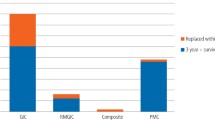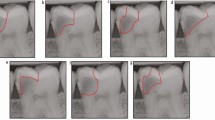Key Points
-
Almost half of the practitioners surveyed were aware of the Atraumatic Restorative Treatment technique (ART).
-
Few practitioners, however, followed ART principles in their practice.
-
Further education on minimal intervention techniques would seem desirable.
Abstract
Background Atraumatic Restorative Treatment (ART) was introduced a decade ago as a minimal intervention treatment for caries in unindustrialised countries, but UK general dental practitioners (GDPs) may also be using this technique.
Objective This study aimed to determine the materials and techniques used by a group of UK GDPs to treat caries in primary teeth.
Method A questionnaire, designed to determine GDPs' use of materials and techniques in the restoration of caries in primary teeth, was distributed to 600 GDPs in Scotland and England, with an explanatory letter and reply-paid envelope. The questionnaire included colour illustrations of two carious cavities in primary molar teeth and a request that respondents draw the cavity outline that they would use on the illustrations. The cavity outlines were assessed independently by two examiners. All other data were collated and analysed.
Results 390 usable replies were received, a response rate of 65%. Of the respondents, 99% treated child patients and 42% of respondents were aware of ART. For treatment of a small Class II cavity, 37% drew a cavity outline without extension beyond removal of caries and a majority suggested use of an adhesive material (51% glass ionomer, 13% compomer). For cavity preparation, 47% of respondents used a drill, 10% an excavator and 41% used both. For treatment of a large occluso-lingual cavity, again most used an adhesive technique (44% glass ionomer, 12% compomer) for its restoration, while 50% used a drill, 7% an excavator and 42% used both for cavity preparation.
Conclusion Most respondents used adhesive materials for restoration of caries in primary molars, but, despite 42% of respondents stating that they were aware of the treatment, 'true' ART was adopted by fewer than 10% of respondents.
Similar content being viewed by others
Log in or create a free account to read this content
Gain free access to this article, as well as selected content from this journal and more on nature.com
or
References
O'Brien M. Children's dental health in the United Kingdom, 1993. London: Her Majesty's Stationery Office, 1994.
Cole BO, Welbury RR . The atruamatic restorative treatment (ART) technique: does it have a place in everyday practice? S Afr Dent J 2001; 56: 321–326.
Levine RS, Pitts NB, Nugent ZJ . The fate of 1587 unrestored carious deciduous teeth:a retrospective general dental practice based study from northern England. Br Dent J 2002; 193: 99–103.
Milsom KM, Tickle M, Blinkhorn AS . Dental pain and dental treatment of young children attending the general dental service. Br Dent J 2002; 192: 280–284.
Tickle M, Milsom KM, Kearney-Mitchell P, Blinkhorn AS . The fate of carious primary teeth of children who regularly attend the general dental service. Br Dent J 2002; 192: 219–223.
McDonald SP, Sheiham A . A clinical comparison of non-traumatic methods of treating caries. Int Dent J 1994; 44: 465–470.
Ribeiro CC, Baratieri LN, Perdigao J, Baratieri NMM, Ritter AV . A clinical, radiographic and scanning electron microscopic evaluation of adhesive restorations on carious dentin in primary teeth. Quintessence Int 1999; 30: 591–599.
Frencken J R . Report on the execution of the Morogoro rotation in primary oral health care in the academic year 1984-1985. University of Dares Salaam, Division of Dentistry, 1985.
Frencken J, Phantumvanit P, Pilot T, Songpaisan Y, van Amerongen E. Manual for Atraumatic Restorative treatment. 1997, WHO Collaborating Centre for Oral Health Services research, Groningen.
Ewoldson N, Covey U . and Lavin M. The physical and adhesive properties of dental cements used for atraumatic restorative treatment. Spec Care Dent 1997; 17: 19–24.
Mjor IA, Gordan VVA . Review of atraumatic restorative treatment (ART). Int Dent J 1999; 49: 127–131.
Lo EC, Luo Y, Clinical investigation of two glass ionomer restoratives used with the atraumatic restorative treatment approach in China: two years results. Caries Res 2001; 35: 458–463.
Dillman DA . Mail and telephone surveys; The Total Design method. New York: John Wiley and sons, 1977.
Phantumvanit P, Songpaisan Y, Pilot T, Frencken JE . Atruamatic Restorative Treatment (ART): a three-year community field trial in Thailand – survival of one surface restorations in the permanent dentition. J Public Health Dent 1996; 56: 141–145.
Frencken JE, Makoni F, Sitholen D . ART restorations and glass ionomer sealants in Zimbabwe:survival after 3 years. Community Dent Oral Epidemiol 1998; 26: 372–381.
Tan RT, Burke FJT . Response rates to questionnaires mailed to dentists. A review of 77 publications. Int Dent J 1997; 47: 349–354.
Sarll DW, Holloway PJ . Factors influencing innovation in general dental practice. Br Dent J 1982; 153: 264–266.
Duggal MS, Nooh A, High A . The relationship between extent of caries involvement of the marginal ridge and pulp inflammation of primary teeth. J Dent Res 1999; 78: 298.
Fayle S . Stainless steel preformed crowns for primary molars. Int J Peadiatric Dent 1999; 9: 31–314.
Frencken JE, Holmgren CJ . The Atraumatic Restorative Treatment (ART) for tooth decay. A Global initiative 1998-2000. Final report and recommendations. World Health Organisation, 2002.
Cole BOI, Welbury RR . The Atraumatic Restorative Treatment (ART) Technique: does it have a place in everyday practice? Dent Update 2000; 27: 118–123.
Van Amerongen W E, Rahimtoola S. Is ART really atraumatic? Community Dent Oral Epidemiol 1999; 27: 431–435.
Schriks MC, van Amerongen WE . Atraumatic aspects of ART: psychological and physiological aspects of treatment with and without rotary instruments. Community Dent Oral Epidemiol 2003; 31: 15–20.
Audit Commission. Dentistry. Primary dental care services in England and Wales. Exhibit 6, p 24. London: The Audit Commission, 2002.
Acknowledgements
The authors acknowledge the financial support of GC Europe NV, Leuven, Belgium for this project, and wish to thank the practitioners who completed and returned the questionnaires. Mr Mike Sharland, Multimedia Services, University of Birmingham School of Dentistry is acknowledged for his help with the illustrations.
Author information
Authors and Affiliations
Corresponding author
Additional information
Refereed paper
Rights and permissions
About this article
Cite this article
Burke, F., McHugh, S., Shaw, L. et al. UK dentists' attitudes and behaviour towards Atraumatic Restorative Treatment for primary teeth. Br Dent J 199, 365–369 (2005). https://doi.org/10.1038/sj.bdj.4812696
Accepted:
Published:
Issue date:
DOI: https://doi.org/10.1038/sj.bdj.4812696
This article is cited by
-
A scoping literature review on minimum intervention dentistry for children with dental caries
British Dental Journal (2022)
-
Atraumatic restorative treatment versus amalgam restoration longevity: a systematic review
Clinical Oral Investigations (2010)
-
Managing dental caries in children in Turkey - a discussion paper
BMC Oral Health (2009)
-
Two years survival rate of class II composite resin restorations prepared by ART with and without a chemomechanical caries removal gel in primary molars
Clinical Oral Investigations (2009)
-
Orale Gesundheitsförderung in Westafrika
Prävention und Gesundheitsförderung (2007)



